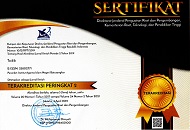Teachers` Method of Teaching English Grammar at the Senior High Schools
Abstract
Keywords
Full Text:
PDFReferences
Andriani, A., Yuniar, V.D., & Abdullah, F. (2021). Teaching English grammar in an Indonesian junior high school. AL-ISHLAH: Jurnal Pendidikan, 13(2), 1046-1056. https://doi.org/1035445/alishlah.v13i2.956
Apsari, Y., Saputra, I. A., & Leriandini, G. (2019). Students` perception of snowball throwing in teaching grammar. Project, 2(2), 52-58. http://dx.doi.org/10.22460/project.v2i2.p152-158
Arifin, S. (2016). Deductive and inductive methods in teaching tenses. Journal of ELT research, 1(1), 73-89. http://dx.doi.org/10.22236/JER_Vol1Issue1
Arikunto, S. (2010). Prosedur penelitian suatu pendekatan praktik. Jakarta: Rineka Cipta.
Bennitez-Correa, C., Gonzales-Torres, P., Ochoa-Cueva, C., & Vargas-Saritama, A. (2019). A comparison between deductive and inductive approaches for teaching EFL grammar to high school students. International Journal of Instruction, 12(1). https://doi.org/10.29333/iji.2019.12115a
Cam, L., & Tran, T. M. T. (2017). An evaluation of using games in teaching English grammar for first year English – majored students at dong nai technology university. International Journal of Learning, Teaching and Educational Research, 16(7), 55-71. https://www.ijlter.org/index.php/ijlter/article/view/962
Creswell, J. W. (2014). Research design: Qualitative, quantitative, and mix method approaches. California: SAGE Publication, Inc.
Creswell, J. W., & Plano Clark, V. L. (2018). Designing and conducting mix method research. California: Sage Publication, Inc
Diaz, A. L., Martinez, J., Jiménez C, D., Perez, E., & Mateo, V. (2019). How we teach grammar: An exploratory study on how Dominican teachers deal with grammar teaching. Mextesol Journal, 43(4), 1-9. https://www.mextesol.net/journal/index.php?page=journal&id_article=15657
Djurayeva, Y., Ayatov, R., & Shegay, A. (2020). Current problems and resolutions of teaching English grammar. SJIF (Scientific Journal Impact Factor), 1(3), 572-576. https://cyberleninka.ru/article/n/current-problems-and-resolutions-of-teaching-english-grammar
Du J. (2017). On the application of situational language teaching method to Mongolian English majors. English Language and Literature Studies, 7(4), 98-103. http://doi.org/10.5539/ells.v7n4p98
Farahani, M. V. (2018). An investigation into inductive and deductive methods in teaching grammar to German EFL learners: A comparative study. Global Journal of Foreign Language Teaching, 8(2), 76-91. https://doi.org/10.18844/gjflt.v8i2.3202
Hendriani, S. (2018). Grammar teaching method preferred by Indonesian students. The Asian EFL journal, 20(11), 83-96. https://www.asian-efl-journal.com/monthly-editions-new/2018-teaching-articles/volume-20-issue-11-2018/index.htm
Komara, C. & Tiarsiwi, F. (2021). Exploring Indonesian EFL learners` perception of English learning grammar. JELTL (Journal of English Language Teaching and Linguistics), 6(2), 459-470. https://dx.doi.org/10.21462/jeltl.v6i2.564
Laptinova, I. I. (2018). Implementation of the situational language teaching approach for English as a foreign language learners. Modern Scientific Researchers, 2(6), 61-70. https://doi.org/10.30889/2523-4692.2018-06-02-060
Larsen-Freeman, D. & Celce-Murcia, M. (2015). The grammar book: form, meaning, and use for english language teachers (3rd ed). United States of America: National Geographic Learning.
Mahdi, A. M. (2018). Difficulties in learning grammar, a study into the context of university of technology, department of materials engineering. Academic scientific Journals, 1(31), 23-31. https://www.iasj.net/iasj/article/149116
Masna, Y. Dahliana, S. & Martaputri, N. A. (2020). Exploring English teachers` perception on using situational language teaching method in teaching vocabulary. Journal GEEJ, 7(2), 283-293. http://doi.org/10.46244/geej.v7i2.1192
Matkasimova, D. B. K., & Makhmudov, K. S. U. (2020). Importance of interactive methos in the English language grammar teaching. Science and Education, 1(2), 95-98. https://openscience.uz/index.php/sciedu/article/view/50
Miles, M. B., Huberman, A. C., & Saldana, J. (2014). Qualitative data analysis: A methods sourcebook (3rd ed). United States of America: SAGE Publication, Inc.
Mishra, S., Jeyasakthi, V., & Velmurugan, K. (2021). The intervention of physical games in teaching English grammar to secondary school students: A review with special reference to the secondary school pupil in Puducherry, India. Psychology and Education, 58(2), 176-185. https://doi.org/10.17762/pae.v58i2.1547
Nurhamsih, Y., & Syahrial, S. (2019). Evaluation of English teaching materials used at a vocational high school based on Cunningsworth`s checklist. JOALL (Journal of Applied Linguistics and Literature), 3(2), 33-46. http://doi.org/10.33369/joall.v3i2.6830
Richards, J. C. (2006). Communicative language teaching today. New York: Cambridge university press.
Richards, J. C., & Rodger, T. S. (2014). Approaches and method in language teaching (3rd ed). Italy: Cambridge University Press.
Souisa, T. R. & Yanuarius, L. (2020). Teachers` strategies on teaching grammar: Facts and expectations of senior high school teacher at Ambon. International Journal of Evaluating and Research in Education, 9(4), 1121-1127. http//dx.doi.org/10.11591/ijere.v9i4.20643
Sugiyono. (2013). Metode penelitian kuantitatif, kualitatif, R&D. Bandung: Alfabeta.
Uleng, B. P. (2021). Teaching preposition through oral situational language teaching method at the first year students of SMP Negeri 33. Jurnal Andi Djemma, 4(1), 1-7. http://dx.doi.org/10.35914/jad.v4i1
Wenrong, L. (2018). The application of situational teaching method to English grammar teaching in senior high school. International Workshop on Advances in Social Sciences, 1095-1102 http://doi.10.25236/iwass.2018.238
Wilujeng, A. P. (2021). Learning method using communicative approaches to English grammar teaching. Karangan: Jurnal Bidang Kependidikan, Pembelajaran, dan Pengembangan, 3(1), 1-6. https://doi.org/10.55273/karangan.v3i1.81
Yunita, W., Mayuni, I., & Emzir, E. (2019). Integrated story – based grammar learning model: The effectiveness and the students` perception on implementation in a grammar classroom. Atlantis Press, 178, 296-303. https://doi.org/10.2991/ICOIE-18.2019.66
DOI: http://dx.doi.org/10.31958/jt.v26i1.6668
Refbacks
- There are currently no refbacks.
Copyright (c) 2023 Nurbaiti Nurbaiti, Wisma Yunita, Syahrial Syahrial, Elvina Gusman

This work is licensed under a Creative Commons Attribution-NonCommercial 4.0 International License.
TA'DIB with registered number e-ISSN: 2580-2771, p-ISSN: 1410-8208 have been indexed on:

Journal Ta'dib distribute under Lisensi Creative Commons Atribusi-NonKomersial 4.0 Internasional.
Contact us: Ta'dib; Address: FTIK, Universitas Islam Negeri Mahmud Yunus Batusangkar; Jl. Sudirman No. 137 Lima Kaum Batusangkar, Tanah Datar, Sumatera Barat, Indonesia. Email: [email protected]

























